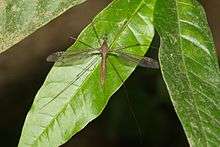Holorusia
Holorusia is a genus of true crane fly, including the largest known crane fly species, Holorusia mikado.[1]
| Holorusia | |
|---|---|
 | |
| Holorusia sp. female | |
| Scientific classification | |
| Kingdom: | |
| Phylum: | |
| Class: | |
| Order: | |
| Suborder: | |
| Infraorder: | |
| Superfamily: | |
| Family: | |
| Subfamily: | |
| Genus: | Holorusia Loew, 1863 |
| Type species | |
| Holorusia rubiginosa Loew, 1863 [= hespera Arnaud & Byers, 1990] | |
| Species | |
|
see text | |
Distribution
Asia & Australasia.
Species
- H. aberrans (Alexander, 1920)
- H. agni Alexander, 1971
- H. albicostigma (Alexander, 1950)
- H. albovittata (Macquart, 1838)
- H. andrewsi (Edwards, 1932)
- H. astarte (Alexander, 1949)
- H. basiflava Yang & Yang, 1993
- H. bioculata (Alexander, 1967)
- H. bitruncata (Alexander, 1950)
- H. borneensis (Brunetti, 1918)
- H. bourbonica (Alexander, 1957)
- H. brobdignagia (Westwood, 1876)
- H. calliergon (Alexander, 1940)
- H. carmichaeli (Brunetti, 1913)
- H. castanea (Macquart, 1838)
- H. cerbereana (Alexander, 1942)
- H. clavipes (Edwards, 1921)
- H. conspicabilis Skuse, 1890
- H. cressida (Alexander, 1953)
- H. damuda Evenhuis, 2006
- H. degeneri Alexander, 1978
- H. dives (Brunetti, 1912)
- H. dohrniana (Enderlein, 1912)
- H. dorsopleuralis (Alexander, 1957)
- H. dravidica (Edwards, 1932)
- H. elobata (Alexander, 1967)
- H. esakii (Takahashi, 1960)
- H. festivipennis (Edwards, 1933)
- H. fijiensis (Alexander, 1921)
- H. flava (Brunetti, 1911)
- H. flavoides (Brunetti, 1918)
- H. fulvipes (Edwards, 1921)
- H. fulvolateralis (Brunetti, 1911)
- H. glebosa Alexander, 1971
- H. globulicornis (Alexander, 1935)
- H. goliath (Alexander, 1941)
- H. hainanensis Yang & Yang, 1997
- H. hansoni (Alexander, 1963)
- H. henana Yang, 1999
- H. herculeana (Alexander, 1941)
- H. hespera Arnaud & Byers, 1990
- H. ignicaudata (Alexander, 1935)
- H. illex (Alexander, 1947)
- H. impictipleura (Alexander, 1957)
- H. inclyta (Alexander, 1949)
- H. incurvata Yang & Yang, 1993
- H. inventa (Walker, 1848)
- H. japvoensis (Alexander, 1953)
- H. lacunosa Alexander, 1971
- H. laticellula (Alexander, 1949)
- H. lepida (Alexander, 1924)
- H. leptostylus (Alexander, 1963)
- H. liberta (Alexander, 1935)
- H. lieftincki (Edwards, 1932)
- H. lineaticeps (Edwards, 1932)
- H. lombokensis (Alexander, 1942)
- H. luteistigmata (Alexander, 1963)
- H. majestica (Brunetti, 1911)
- H. makara (Alexander, 1967)
- H. malayensis (Edwards, 1932)
- H. mamare Evenhuis, 2006
- H. mara (Alexander, 1953)
- H. mikado (Westwood, 1876)
- H. mitra Alexander, 1969
- H. molybros (Alexander, 1957)
- H. monochroa (Wiedemann, 1828)
- H. nagana (Alexander, 1953)
- H. nampoina (Alexander, 1963)
- H. nigricauda (Edwards, 1925)
- H. nigrofemorata (Alexander, 1967)
- H. nimba (Alexander, 1936)
- H. nirvana (Alexander, 1961)
- H. novaeguineae (de Meijere, 1913)
- H. nudicaudata (Edwards, 1932)
- H. ochripes (Brunetti, 1911)
- H. oosterbroeki Yang & Yang, 1997
- H. ornatithorax (Brunetti, 1911)
- H. palauensis (Alexander, 1940)
- H. pallescens (Edwards, 1926)
- H. pallifrons (Edwards, 1932)
- H. pauliani (Alexander, 1955)
- H. penumbrina (Edwards, 1919)
- H. percontracta (Alexander, 1947)
- H. perobtusa (Alexander, 1961)
- H. persessilis (Alexander, 1941)
- H. picturata Evenhuis, 2006
- H. pluto (Brunetti, 1911)
- H. praepotens (Wiedemann, 1828)
- H. punctifrons (Róndani, 1875)
- H. punctipennis (Edwards, 1926)
- H. quadrifasciculata (Alexander, 1935)
- H. quathlambica (Alexander, 1956)
- H. radama (Alexander, 1963)
- H. rector (Edwards, 1926)
- H. regia (Alexander, 1935)
- H. rex (Alexander, 1917)
- H. rogeziana (Alexander, 1955)
- H. sakarahana (Alexander, 1960)
- H. schlingeri Evenhuis, 2006
- H. similis (Edwards, 1921)
- H. simplicitarsis (Alexander, 1963)
- H. siva (Alexander, 1950)
- H. sordidithorax (Alexander, 1953)
- H. striaticeps (Alexander, 1957)
- H. sufflava (Alexander, 1957)
- H. umbrina (Wiedemann, 1828)
- H. vanewrighti Alexander, 1971
- H. viettei (Alexander, 1957)
- H. vinsoniana (Alexander, 1956)
- H. vishnu Alexander, 1971
- H. walkeriana (Alexander, 1924)
- H. yama Alexander, 1969
gollark: Oh, it also knows that because things actually have length on them in good languages.
gollark: It doesn't. It reads nbyte bytes and says how much it did. This is common.
gollark: I'm considering rewriting it in Rust again as it will never achieve completion anyway.
gollark: Distributed systems are hard.
gollark: The current prototype(s) (well, the least incomplete ones) are server rendered (server generates mostly static HTML) webapps backed by SQLite.
This article is issued from Wikipedia. The text is licensed under Creative Commons - Attribution - Sharealike. Additional terms may apply for the media files.